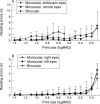Monocular and binocular reading performance in children with microstrabismic amblyopia
- PMID: 16170125
- PMCID: PMC1772895
- DOI: 10.1136/bjo.2005.066688
Monocular and binocular reading performance in children with microstrabismic amblyopia
Abstract
Aim: To evaluate if functionally relevant deficits in reading performance exist in children with essential microstrabismic amblyopia by comparing the monocular and binocular reading performance with the reading performance of normal sighted children with full visual acuity in both eyes.
Methods: The reading performance of 40 children (mean age 11.6 (SD 1.4) years) was evaluated monocularly and binocularly in randomised order, using standardised reading charts for the simultaneous determination of reading acuity and speed. 20 of the tested children were under treatment for unilateral microstrabismic amblyopia (visual acuity in the amblyopic eyes: logMAR 0.19 (0.15); fellow eyes -0.1 (0.07)); the others were normal sighted controls (visual acuity in the right eyes -0.04 (0.15); left eyes -0.08 (0.07)).
Results: In respect of the binocular maximum reading speed (MRS), significant differences were found between the children with microstrabismic amblyopia and the normal controls (p = 0.03): whereas the controls achieved a binocular MRS of 200.4 (11) wpm (words per minute), the children with unilateral amblyopia achieved only a binocular MRS of 172.9 (43.9) wpm. No significant differences between the two groups were found in respect of the binocular logMAR visual acuity and reading acuity (p>0.05). For the monocular reading performance, significant impairment was found in the amblyopic eyes, whereas no significant differences were found between the sound fellow eyes of the amblyopic children and the control group.
Conclusion: In binocular MRS, significant differences could be found between children with microstrabismic amblyopia and normal controls. This result indicates the presence of a functionally relevant reading impairment, even though the binocular visual acuity and reading acuity were both comparable with the control group.
Figures



References
-
- Monestam E, Wachtmeister L. The impact of cataract surgery on low vision patients. A population based study. Acta Ophthalmol Scand 1997;75:569–76. - PubMed
-
- Uusitalo RJ, Brans T, Pessi T, et al. Evaluating cataract surgery gains by assessing patients’ quality of life using the VF-7. J Cataract Refract Surg 1999;25:989–94. - PubMed
-
- Duke-Elder S, Wybar K. Ocular motility and strabismus. St Louis: CV Mosby, 1973:294.
-
- Von Noorden GK. Burian-von Noorden’s binocular vision and ocular motility: theory and management of strabismus. 2nd ed. St Louis: CV Mosby, 1980:436–47.
-
- Vinding T, Gregersen E, Jensen A, et al. Prevalence of amblyopia in old people without previous screening and treatment: an evaluation of the present prophylactic procedures among children in Denmark. Acta Ophthalmol 1991;69:796–8. - PubMed
Publication types
MeSH terms
LinkOut - more resources
Full Text Sources
Other Literature Sources
Medical
